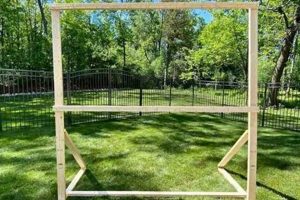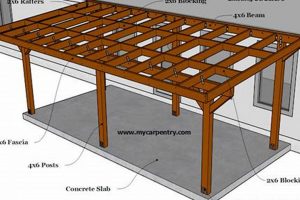The process of constructing a structure, designed and built by an individual or group, specifically for the purpose of holding targets for firearms practice, is a cost-effective alternative to commercially available options. These self-made supports vary widely in design, utilizing diverse materials and construction techniques. Examples include frames constructed from wood, PVC pipe, or repurposed metal, often designed for easy assembly and portability.
Creating these target holders offers numerous advantages, including reduced expense, customization to specific needs, and the satisfaction of a do-it-yourself project. Historically, individuals have crafted their own shooting equipment due to limited availability or affordability. This approach allows for tailoring the dimensions and materials to accommodate different target sizes, terrain, and shooting disciplines, enhancing the training experience.
The following sections will delve into specific designs, material considerations, and safety precautions involved in constructing effective and durable devices for supporting targets. This detailed examination will enable individuals to undertake the fabrication process with a comprehensive understanding of best practices and potential challenges.
Construction Guidance for Target Holders
The following points outline critical considerations for individuals undertaking the fabrication of devices to hold shooting targets.
Tip 1: Material Selection: Employ materials suitable for outdoor use and resistant to projectile impact when constructing target supports. Pressure-treated lumber or heavy-duty PVC offer increased durability compared to standard alternatives.
Tip 2: Stability and Base Design: Ensure a stable base to prevent tipping during use. A wide stance or weighted base provides increased stability, particularly in windy conditions or on uneven terrain. Consider incorporating ground stakes for further anchoring.
Tip 3: Target Attachment Method: Develop a secure and easily replaceable target attachment system. Clamps, stapled cardboard, or secured target backers can facilitate quick changes and minimize damage to the support structure.
Tip 4: Portability Considerations: Design the support for easy disassembly and transport. Modular designs with removable legs or folding frames enhance portability for use at different locations. Consider the weight of the materials used for ease of handling.
Tip 5: Safety Buffer: Incorporate a backstop or buffer behind the target to contain stray projectiles and prevent ricochets. This reduces the risk of unintended impacts and enhances safety for shooters and bystanders. A sheet of plywood or heavy fabric can serve as an effective backstop.
Tip 6: Compliance with Regulations: Verify compliance with all applicable local and range regulations regarding target support construction and use. Adherence to regulations ensures safe and legal operation.
Tip 7: Regular Inspection: Routinely inspect the support for damage or wear. Replace damaged components promptly to maintain structural integrity and ensure safe operation. Look for signs of rot, cracking, or projectile damage.
Proper material selection, stable design, and adherence to safety guidelines are paramount in creating a functional and secure device. These considerations mitigate the risk of accidents and maximize the utility of the self-made target apparatus.
The subsequent section will discuss specific designs and provide further guidance on ensuring the safety and longevity of self-constructed target holders.
1. Material Durability
Material selection fundamentally determines the lifespan and safety of a self-constructed target holder. The ability of the materials to withstand repeated projectile impacts and environmental exposure is paramount for a reliable and long-lasting structure. Inadequate material selection compromises the stand’s integrity, potentially leading to premature failure and increased safety risks.
- Resistance to Projectile Impact
The primary function of a device intended to hold shooting targets necessitates resistance to direct projectile strikes. Materials like pressure-treated lumber, steel, or ballistic nylon provide a degree of impact resistance, preventing immediate structural failure. The choice of material should correspond with the expected caliber and frequency of use to mitigate damage and prolong the stand’s service life. Examples include using thicker gauge steel for high-caliber rifles or reinforced lumber for shotgun applications.
- Weather Resistance
Outdoor use subjects target holders to environmental factors such as rain, sunlight, and temperature fluctuations. Materials susceptible to rot, corrosion, or UV degradation require frequent replacement, increasing maintenance costs and reducing the stand’s reliability. Opting for weather-resistant materials, like treated lumber or powder-coated steel, minimizes the effects of environmental exposure. An untreated wood stand might degrade within a year due to rot, while a properly treated stand can last for several years.
- Structural Integrity Under Stress
Repeated impacts and environmental stressors can weaken the structural integrity of the materials used. The capacity of the material to maintain its shape and load-bearing ability under stress is crucial. Materials with high tensile strength and resistance to bending or warping are preferred. For example, using thin-walled PVC pipe may lead to structural failure under impact or from prolonged exposure to sunlight, whereas reinforced steel provides greater structural stability.
- Maintenance Requirements
The choice of materials affects the level of maintenance required to preserve the stand’s functionality. Some materials may necessitate regular painting, sealing, or rust removal to maintain their protective properties. Selecting low-maintenance materials reduces the time and expense associated with upkeep. For example, aluminum requires minimal maintenance compared to unfinished steel, which is prone to rusting. Lower maintenance equates to greater usability and less downtime for repairs.
These factors collectively emphasize that careful consideration of material durability is essential when undertaking the design and construction of a device intended to hold shooting targets. Selecting materials based on their impact resistance, weather resistance, structural integrity, and ease of maintenance ensures a robust and reliable structure, enhancing safety and longevity. Ignoring these considerations can lead to a substandard product prone to early failure, creating potential safety hazards and increasing long-term costs.
2. Structural Stability
Structural stability represents a foundational element in the successful design and implementation of self-constructed target holders. A lack of stability directly correlates with compromised safety and diminished functionality. The inherent purpose of these devicesto securely present targets for shooting practicecannot be achieved if the structure is prone to tipping, collapsing, or shifting during use. Consequently, design choices impacting stability must be prioritized.
Consider a simple A-frame target stand constructed from insufficiently braced lumber. Under the force of wind or even minor impacts from errant projectiles, the frame may become unstable, causing the target to fall. This not only disrupts the shooting session but also introduces a safety hazard. Conversely, a stand designed with a wide base, properly angled supports, and reinforced joints exhibits greater resistance to external forces, maintaining its position and presenting the target consistently. This enhanced stability ensures a safer and more effective practice environment. Further, materials selected must also accommodate load to ensure structural integrity over time, preventing sagging or eventual collapse under consistent use.
In summary, structural stability is not merely an aesthetic consideration but a critical determinant of the target stand’s safety and functionality. A well-engineered design that emphasizes a broad, stable base, robust material connections, and resistance to external forces is essential. Failure to address these factors can result in a compromised structure, undermining the intended purpose and introducing significant risks. Therefore, stability requirements must guide the entire design and construction process.
3. Target Affixation
Target affixation, the method by which targets are secured to self-constructed shooting target stands, directly influences the efficacy and safety of firearms practice. The chosen attachment method must reliably maintain target placement while accommodating swift replacement or adjustment. Variability in target size, material, and intended use necessitates careful consideration of the affixation strategy.
- Secure Retention
The primary function of target affixation is to prevent unintended dislodgement during shooting activities. Methods must withstand the impact of projectiles and environmental factors, such as wind. Examples include the use of heavy-duty staples for cardboard targets, clamping mechanisms for steel targets, or adhesive systems for paper targets. Failure to ensure secure retention can lead to inconsistent shot placement data and potential safety hazards should a target detach unexpectedly.
- Ease of Replacement
Frequent target changes are inherent to shooting practice. Affixation methods that impede rapid target replacement disrupt the flow of training. Designs incorporating clips, spring-loaded mechanisms, or easily removable backing boards facilitate efficient target swaps. Conversely, systems requiring tools or extensive disassembly prolong downtime and decrease training effectiveness. A design that accommodates a variety of target sizes further streamlines the replacement process.
- Material Compatibility
Compatibility between the target material and the chosen affixation method is critical for long-term functionality. Staples suitable for cardboard may be ineffective for thicker materials like foam or plastic. Adhesives must bond effectively without damaging the target surface. Mechanical clamps should distribute pressure evenly to prevent tearing or distortion. Incompatible combinations can lead to premature target degradation or detachment during use.
- Safety Considerations
The affixation system should not introduce additional safety risks. Sharp edges, protruding hardware, or easily broken components present potential hazards to the user. Recessed fasteners, rounded edges, and durable materials minimize the risk of injury. The design should also prevent ricochet or fragmentation upon projectile impact. Implementing a backing board can further enhance safety by containing fragments and preventing pass-through.
Effective target affixation is integral to a well-designed, self-constructed target stand. Selecting appropriate materials, employing secure attachment methods, and prioritizing ease of replacement and user safety collectively contribute to an optimized shooting practice experience. These considerations directly impact the overall functionality and safety of devices created for supporting targets.
4. Design Portability
The incorporation of design portability into self-constructed shooting target stands represents a practical consideration, influencing the versatility and usability of the resulting structure. The ability to readily transport and deploy a target stand expands its utility beyond fixed locations, facilitating training in diverse environments.
- Modular Construction
Modular design entails segmenting the target stand into discrete components that can be assembled and disassembled with minimal effort. This approach allows for compact storage and simplifies transportation. Examples include using detachable legs secured with bolts or pins, or creating a frame that breaks down into smaller sections. This modularity directly impacts the ease with which the target stand can be moved between storage, transport vehicles, and shooting locations.
- Lightweight Materials
Employing lightweight materials reduces the overall weight of the target stand, making it easier to carry and maneuver. Aluminum, PVC, and certain types of wood offer a balance between strength and weight. Conversely, using heavy steel or dense lumber can significantly hinder portability. The choice of materials should align with the intended use and frequency of transport, considering the trade-offs between durability and ease of handling.
- Collapsible Frameworks
Designs that incorporate a collapsible framework enable the target stand to fold down into a compact configuration. Hinged joints and telescoping components facilitate this functionality. Examples include A-frame stands that fold flat or tripods with retractable legs. This approach minimizes the storage footprint and simplifies transport, particularly in vehicles with limited cargo space. The design should ensure that the folding mechanism is secure and prevents unintended collapse during use.
- Integrated Carrying Handles
The addition of integrated carrying handles enhances the ease of transporting the target stand, particularly when it cannot be fully disassembled. Handles can be incorporated into the frame or attached to the legs, providing a secure grip. The placement and design of the handles should distribute the weight evenly and prevent strain on the user. Ergonomic handles improve comfort during transport and reduce the risk of injury.
These design considerations collectively contribute to the overall portability of self-constructed shooting target stands. Prioritizing modular construction, lightweight materials, collapsible frameworks, and integrated carrying handles enables individuals to efficiently transport and deploy their target stands in various shooting environments. This enhanced portability expands the usability and versatility of the structure, accommodating diverse training needs.
5. Safety Buffer
A safety buffer, in the context of a self-constructed device to hold shooting targets, denotes a barrier or design element implemented to mitigate the hazards associated with errant projectiles or ricochets. Its primary function is to protect individuals and property from unintended impacts resulting from shooting activities. This protective measure is integral to the overall safety profile of any structure designed to support targets for firearms practice. Absence of a sufficient safety buffer increases the potential for injury or damage stemming from deflected projectiles.
For example, constructing a target support using only a thin wooden frame provides negligible protection against bullets that miss the intended target. In such scenarios, projectiles can pass through the frame or ricochet off of nearby hard surfaces, posing a significant risk to individuals in the vicinity. Conversely, incorporating a backstop constructed from multiple layers of plywood, ballistic fabric, or a berm of earth creates a physical barrier capable of absorbing or deflecting errant shots. This proactive safety measure significantly reduces the likelihood of unintended injuries or property damage. Another practical application involves angling the target support slightly downward to direct ricochets toward the ground, minimizing the potential for horizontal deflections. Such implementations highlight the tangible benefits of incorporating a robust safety buffer.
In summary, the inclusion of a safety buffer represents a critical aspect of responsible design and construction of devices intended to hold shooting targets. A properly implemented safety buffer mitigates the inherent risks associated with firearms practice, safeguarding individuals and property from the consequences of errant projectiles. The effectiveness of a safety buffer depends on material selection, construction techniques, and proper deployment. Understanding the necessity and practical implementation of safety buffers remains paramount for responsible firearms enthusiasts engaged in building their target systems.
6. Regulatory Compliance
The intersection of regulatory compliance and self-constructed shooting target stands represents a critical facet of responsible firearms practice. Failure to adhere to relevant regulations can result in legal repercussions, safety hazards, and environmental damage. Therefore, understanding and adhering to applicable rules governing target stand construction and usage is paramount. The nature and stringency of these regulations can vary significantly based on locale, ranging from municipal ordinances to federal guidelines, impacting design parameters and permissible locations for target practice.
For example, many jurisdictions impose restrictions on the type of materials permitted for target construction, aiming to minimize environmental contamination from lead or other hazardous substances. Other regulations may dictate minimum distances from residences, roadways, or waterways for shooting activities, thereby influencing where self-constructed target stands can be legally deployed. Similarly, some shooting ranges mandate specific target stand dimensions or construction methods to ensure uniformity and safety across all firing lanes. Non-compliance with these regulations can lead to fines, legal action, or the closure of shooting ranges. A practical understanding of these requirements, therefore, becomes an integral part of the entire process, from design to implementation of the target support.
In summary, ensuring regulatory compliance is not an optional addendum but a fundamental element of safe and lawful self-constructed shooting target stand usage. Awareness of, and adherence to, all applicable federal, state, and local regulations is crucial for responsible firearms ownership and practice. While the specific regulations vary, the principle of abiding by established rules remains constant, safeguarding both individuals and the environment.
Frequently Asked Questions
The following section addresses common inquiries regarding the design, construction, and safety aspects of building structures for supporting shooting targets.
Question 1: What are the primary safety considerations when constructing a shooting target support?
Safety concerns center on structural stability, projectile containment, and adherence to range regulations. Structural integrity prevents collapse, projectile containment minimizes ricochet risks, and regulatory compliance ensures legal operation. Ignoring these considerations elevates the risk of injury or property damage.
Question 2: What materials are best suited for a durable target stand?
Pressure-treated lumber, steel, and heavy-duty PVC offer superior durability for outdoor use. These materials resist weathering and projectile impact. The choice depends on budget, available tools, and the intended use of the support.
Question 3: How can a target stand be made portable?
Portability is achieved through modular designs, lightweight materials, and collapsible frameworks. Detachable legs, aluminum construction, and hinged joints facilitate easy transport. Compromises between portability and structural integrity may be necessary.
Question 4: What is the purpose of a safety buffer behind the target?
A safety buffer, such as a backstop, contains stray projectiles and minimizes ricochets. This reduces the risk of unintended impacts and enhances safety for shooters and bystanders. Plywood, ballistic fabric, or earth berms can serve as effective safety buffers.
Question 5: How is target retention best achieved?
Secure target retention prevents dislodgement during shooting activities. Clamps, staples, or secured target backers provide reliable affixation. The method chosen should be compatible with the target material and allow for easy replacement.
Question 6: What regulations apply to self-constructed target supports?
Regulations vary by locale and may pertain to material usage, shooting distances, or specific range requirements. Compliance with all applicable regulations is essential for safe and legal operation. Consulting local authorities or range officials is advisable.
A comprehensive understanding of these aspects is crucial for constructing a safe, functional, and compliant shooting target support.
The subsequent section will explore advanced design concepts and further refine the principles of target stand construction.
Shooting Target Stand DIY
The preceding discourse has illuminated salient factors pertinent to creating devices intended to hold shooting targets. The exploration encompasses material durability, structural integrity, target retention, design portability, safety buffers, and regulatory compliance. Adherence to these principles directly influences the safety and effectiveness of the completed device. A nuanced understanding of each element contributes to responsible construction.
The decision to engage in the “shooting target stand diy” process necessitates a commitment to safety, precision, and regulatory awareness. Thoughtful planning and execution can result in a cost-effective and tailored solution. Ultimately, the value lies not only in the cost savings, but in the enhanced understanding of shooting safety and responsible firearms practices. Prudent implementation of the knowledge presented herein is paramount for individuals engaging in target stand construction.







